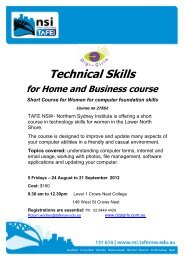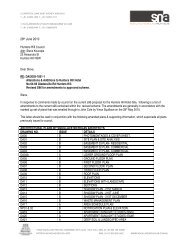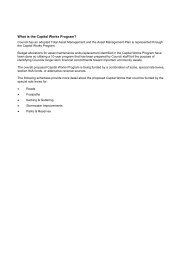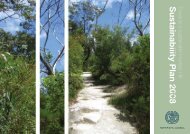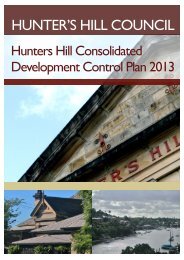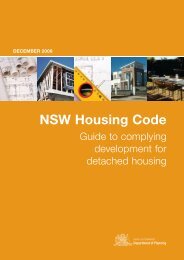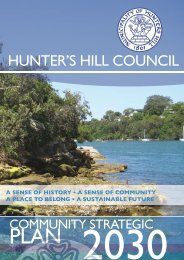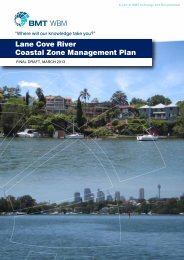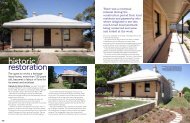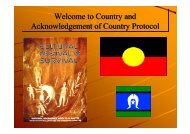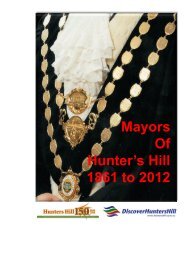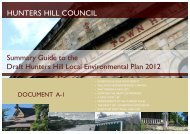Northern Sydney Aboriginal Social Plan
LC_ASP.pdf - Hunter's Hill Council - NSW Government
LC_ASP.pdf - Hunter's Hill Council - NSW Government
- No tags were found...
Create successful ePaper yourself
Turn your PDF publications into a flip-book with our unique Google optimized e-Paper software.
4. Housing<br />
Stable and affordable housing was identifi ed in<br />
consultations as extremely important for <strong>Aboriginal</strong><br />
families living in the <strong>Northern</strong> <strong>Sydney</strong> region. Shelter<br />
NSW (2005) sets a benchmark of no more than 30%<br />
of gross income in mortgage repayments or rent as<br />
an indicator of housing affordability. Families and<br />
individuals that need to pay more than 30% of their<br />
income on housing costs are said to experience<br />
“housing stress”. Analysis of 2001 Census data<br />
indicates a relatively high level of housing stress<br />
among <strong>Aboriginal</strong> residents. Based on this data<br />
an estimated 35% of <strong>Aboriginal</strong> people who rent<br />
properties in the private rental market paid over 30%<br />
of household income in rent. Amongst <strong>Aboriginal</strong><br />
homeowners, an estimated 18% of owners require<br />
more than 30% of household income to meet<br />
mortgage repayments.<br />
Relatively high land values and rents within the<br />
region exacerbate this issue. Lack of affordable<br />
housing may also break down social and family<br />
connections as young people or older people from<br />
families who have traditionally resided in the area<br />
are forced to move outside the region in order to<br />
obtain affordable accommodation (<strong>Northern</strong> Beaches<br />
Key Worker Study, 2004). There is also research<br />
evidence that <strong>Aboriginal</strong> people living in urban areas<br />
may experience racism in the rental property market<br />
(National <strong>Aboriginal</strong> Community Controlled Health<br />
Organisation, 2001, p3).<br />
There are local reports of overcrowding in<br />
accommodation causing stress on families.<br />
According to Census data, eight percent of <strong>Aboriginal</strong><br />
households, compared with fi ve percent of the non-<br />
<strong>Aboriginal</strong> households are regarded as crowded.<br />
However the actual rate may be much higher.<br />
<strong>Aboriginal</strong> households in the <strong>Northern</strong> <strong>Sydney</strong> region<br />
on average had 2.8 people living in them compared<br />
to the average non-<strong>Aboriginal</strong> household with 2.6<br />
people. <strong>Aboriginal</strong> households are more commonly<br />
larger than non-<strong>Aboriginal</strong> households and the<br />
proportion with six or more people in them was 1.8<br />
times higher than that of non-<strong>Aboriginal</strong> households.<br />
The quality of housing available to low or medium<br />
income <strong>Aboriginal</strong> people is also of concern and<br />
may contribute to increased health problems or<br />
put inhabitants at risk of harm. On Census night<br />
2001, roughly 1% of <strong>Aboriginal</strong> people in the<br />
<strong>Northern</strong> <strong>Sydney</strong> region lived in caravans, cabins or<br />
houseboats and 1.5% live outdoors or in improvised<br />
housing conditions. The proportion of people living in<br />
these circumstances is 17 times higher than for non-<br />
<strong>Aboriginal</strong> people.<br />
In addition to public housing provided by the<br />
Department of Housing, the Metropolitan Local<br />
<strong>Aboriginal</strong> Land Council (MLALC) leases houses to<br />
its members at reduced rents. Rents are utilised for<br />
the maintenance of residences and payment of rates.<br />
MLALC’s Housing Unit is also responsible for the<br />
lobbying for accommodation through the <strong>Aboriginal</strong><br />
Housing Organisation and other government bodies.<br />
MLALC is currently working in close consultation with<br />
NSW <strong>Aboriginal</strong> Land Council for the development<br />
of an appropriate home ownership scheme that will<br />
assist members to purchase of their own houses.<br />
Key Objectives:<br />
In regard to <strong>Aboriginal</strong> housing needs our objectives<br />
are that:<br />
• the housing needs of <strong>Aboriginal</strong> individuals and<br />
families are identifi ed and specifi c support is<br />
provided<br />
• waiting lists for social housing are reduced and<br />
more emergency housing options provided<br />
• current Department of Housing and <strong>Aboriginal</strong><br />
Housing Offi ce options are evaluated.<br />
Flags Flying, Manly Wharf<br />
page 38<br />
<strong>Northern</strong> <strong>Sydney</strong> <strong>Aboriginal</strong> <strong>Social</strong> <strong>Plan</strong> 2007-2011




